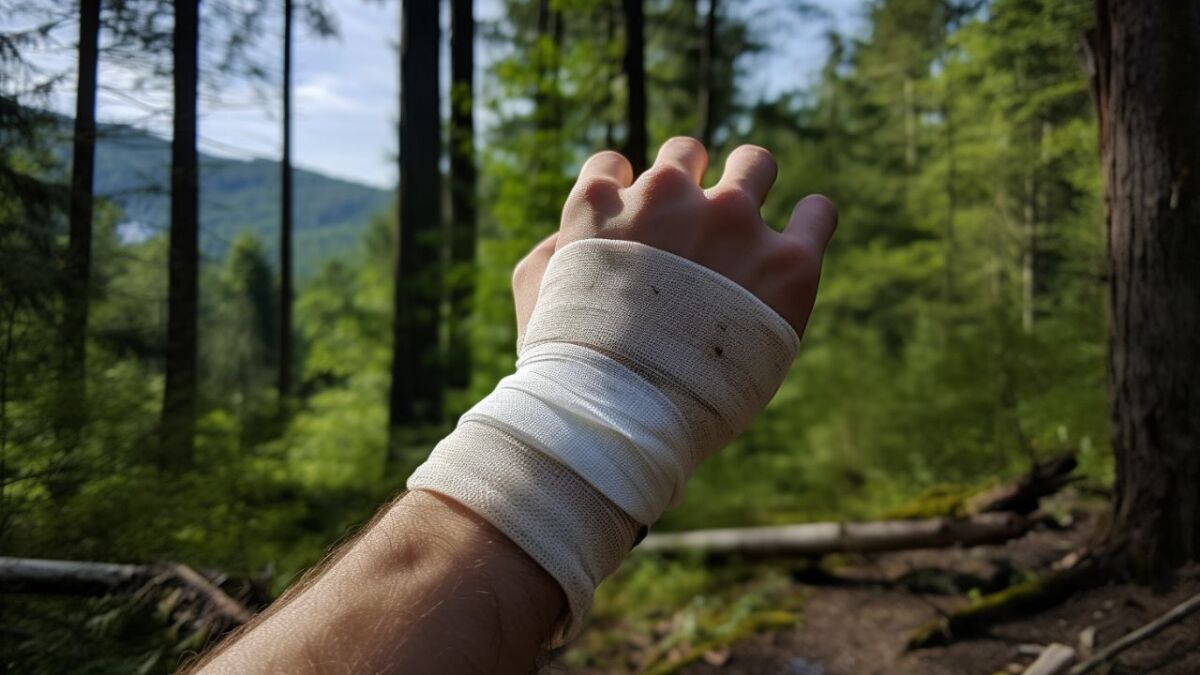
compression bandage
Noun
Meaning
A compression bandage is an essential item in the world of survival, wilderness, and outdoor activities. It is a specially designed bandage that applies pressure to a wound or injury to control bleeding and reduce swelling. In emergency situations, such as when hiking, camping, or in a survival scenario, a compression bandage can be a lifesaver. It helps to stabilize injuries, prevent further damage, and promote faster healing. With its compact size and lightweight design, a compression bandage is a must-have in any outdoor first aid kit. It is a versatile tool that can make a significant difference in critical situations.

Examples
„I was out hiking in the wilderness when I accidentally cut my leg on a sharp rock. Luckily, I had a compression bandage in my first aid kit, so I quickly wrapped it around my wound to stop the bleeding.“
„During a survival training course, one of the participants sprained their ankle while navigating through rough terrain. We immediately applied a compression bandage to reduce the swelling and provide support to the injured joint.“
„While on a camping trip, my friend burned his hand while cooking over the campfire. We used a compression bandage to cover the burn and protect it from further damage.“
„In a recent bushcraft workshop, we learned about the importance of carrying a compression bandage in our survival kits. It can be a lifesaver in case of severe bleeding or injuries that require pressure to control the bleeding.“
„When I go on solo wilderness adventures, I always make sure to pack a compression bandage. It's a versatile tool that can be used for various injuries, from sprains and strains to deep cuts and wounds.“
Origin
The term "compression bandage" originates from the medical field and has its roots in the Latin word "compressio," which means "to press together." The concept of using compression to treat injuries and promote healing has been practiced for centuries.
Compression bandages have evolved over time, with advancements in materials and techniques. In ancient times, various materials such as animal skins, leaves, and cloth were used to apply pressure to wounds. In the 19th century, the development of elastic bandages revolutionized the field of medical compression.
Today, compression bandages are widely used in first aid and medical settings to control bleeding, reduce swelling, and provide support to injured limbs. They are typically made from elastic or stretchable materials that can be wrapped tightly around the affected area to apply pressure.
Compression bandages are an essential component of any first aid kit and are particularly useful in treating sprains, strains, and other soft tissue injuries. They help to limit the movement of injured body parts, reduce pain and inflammation, and promote faster healing.
Overall, compression bandages play a crucial role in the field of medicine and are an important tool for managing injuries and promoting recovery.
Synonyms
Elastic bandage, Pressure bandage, Wrap, Dressing, Tourniquet, Gauze, Medical bandage, First aid bandage
Antonyms
Loose bandage, Non-compressive bandage, Non-tight bandage, Non-constricting bandage, Non-squeezing bandage, Non-binding bandage, Non-restrictive bandage, Non-tightening bandage
Relatives
First aid, Emergency, Wound, Bleeding, Trauma, Medical, Injury, Pressure
Historical and cultural importance
A compression bandage is a crucial tool in the field of first aid and emergency medical care. Its historical and cultural relevance lies in its ability to provide immediate support and aid in the healing process of injuries.
Throughout history, compression bandages have been used by various cultures and civilizations to treat wounds and reduce swelling. Ancient Egyptians, for example, used linen bandages to wrap injured limbs, applying pressure to control bleeding and promote healing. Similarly, ancient Greek and Roman physicians recognized the benefits of compression bandages in managing injuries and preventing further damage.
In modern times, compression bandages have become an essential component of first aid kits and emergency medical supplies. They are commonly used to treat sprains, strains, and other soft tissue injuries by applying pressure to the affected area, which helps reduce swelling and stabilize the injured limb or joint.
Compression bandages are also widely used in sports medicine to support injured muscles and joints, allowing athletes to continue their activities with reduced pain and risk of further injury. Additionally, they play a crucial role in the treatment of conditions such as lymphedema, where the application of pressure helps improve lymphatic drainage and reduce swelling.
Overall, the historical and cultural significance of compression bandages highlights their effectiveness in providing immediate support and aiding in the healing process of various injuries. Their widespread use in different cultures and throughout history underscores their importance in the field of first aid and emergency medical care.
More information about the term compression bandage
What is a Compression Bandage?
A compression bandage is a medical device used to apply pressure to a specific area of the body in order to control bleeding, reduce swelling, and provide support. It is commonly used in first aid and emergency situations, as well as in the treatment of various injuries and medical conditions.
How Does a Compression Bandage Work?
A compression bandage works by exerting pressure on the affected area, which helps to constrict blood vessels and reduce blood flow. This pressure helps to control bleeding and prevent further injury. Additionally, the compression bandage helps to reduce swelling by preventing the accumulation of fluid in the injured area.
Compression bandages are typically made of elastic materials that can stretch and conform to the shape of the body. They are designed to be wrapped tightly around the affected area, ensuring a snug fit and optimal compression.
When Should You Use a Compression Bandage?
A compression bandage is commonly used in the following situations:
- Control bleeding: A compression bandage can be used to apply pressure to a bleeding wound, helping to stop or slow down the bleeding.
- Sprains and strains: Compression bandages are often used to provide support and reduce swelling in cases of sprains and strains.
- Fractures: In some cases, a compression bandage may be used to immobilize a fractured bone and provide support during the healing process.
- Varicose veins: Compression bandages can help to alleviate symptoms and improve circulation in individuals with varicose veins.
How to Apply a Compression Bandage
When applying a compression bandage, it is important to follow these steps:
- Clean the affected area: Before applying the bandage, clean the wound or injured area to prevent infection.
- Wrap the bandage: Start at the furthest point from the heart and wrap the bandage firmly but not too tightly around the affected area. Overlap the bandage by about half of its width with each turn.
- Secure the bandage: Use clips or tape to secure the end of the bandage in place.
- Check circulation: After applying the bandage, check for any signs of impaired circulation, such as numbness, tingling, or discoloration. If these symptoms occur, loosen the bandage slightly.
Conclusion
A compression bandage is a versatile and essential tool in first aid and emergency situations. It provides immediate support, controls bleeding, reduces swelling, and promotes healing. Knowing how to properly apply a compression bandage can make a significant difference in the outcome of an injury or medical condition.
Back to overview

